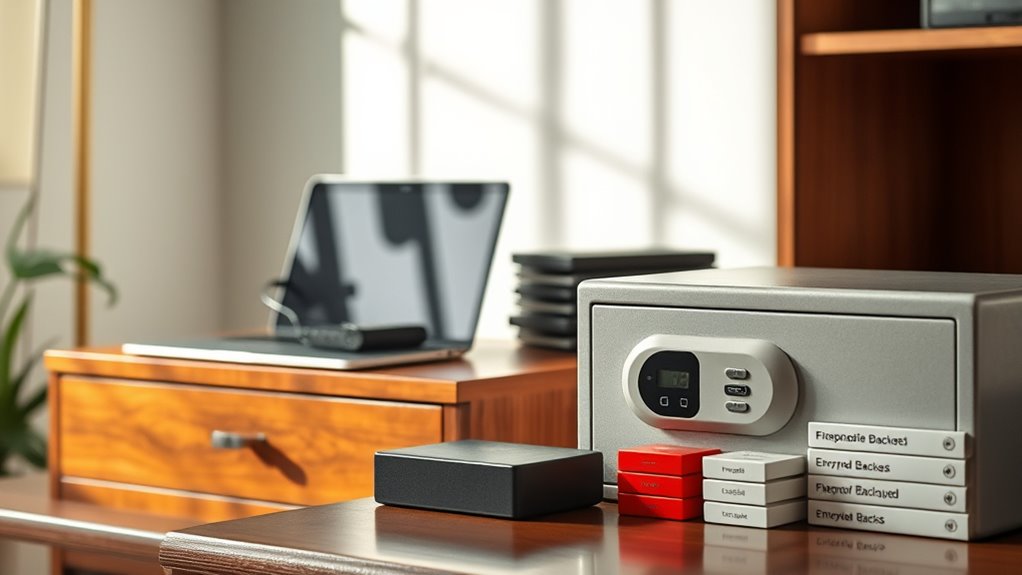To safely handle and store personal data backups at home, choose trusted devices like encrypted external drives or secure cloud services, and use strong, unique passwords with two-factor authentication. Encrypt your files and keep backups in multiple locations, such as a safe or offsite cloud storage. Regularly update, verify, and organize your backups to guarantee they’re current and accessible. Keep security controls tight and periodically check your setup for vulnerabilities to stay protected—more tips lie ahead.
Key Takeaways
- Use reputable cloud services with strong encryption and secure external drives with hardware encryption for backups.
- Regularly update and verify backup integrity through scheduled tests and audits.
- Store physical backups in secure locations, such as safes or locked cabinets, separate from original devices.
- Manage access permissions carefully, enabling two-factor authentication and maintaining a record of authorized users.
- Organize backups with clear labeling, logical folder structures, and routine inventory reviews to ensure data safety and easy retrieval.
Choosing Secure Backup Devices
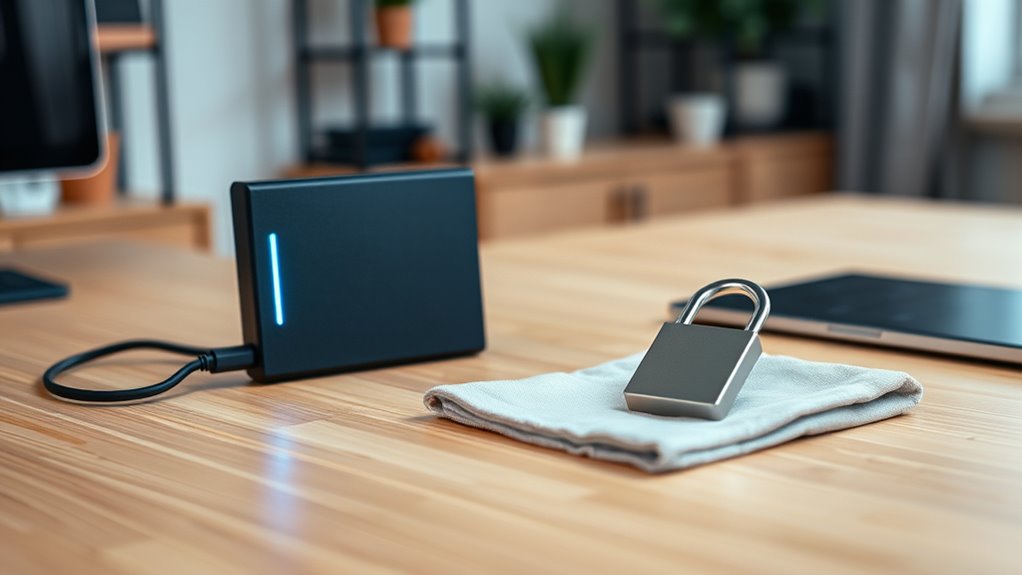
When selecting backup devices for your personal data, security should be your top priority. Cloud storage offers convenience and automatic backups, but make certain you choose reputable providers with strong encryption and privacy policies. External drives provide physical control and quick access, but they need to be well-protected from theft, damage, or loss. Look for external drives with hardware encryption and robust build quality. Combining both options can give you a balanced approach—cloud storage for ease and redundancy, external drives for local backups. Always verify that your chosen devices have up-to-date security features. Avoid cheap or unverified solutions, and consider additional protective measures like encryption and secure access controls to keep your data safe. Additionally, understanding contrast ratio can help you assess the overall security of your backup devices, ensuring clear visibility and reliable performance.
Implementing Strong Password Protections
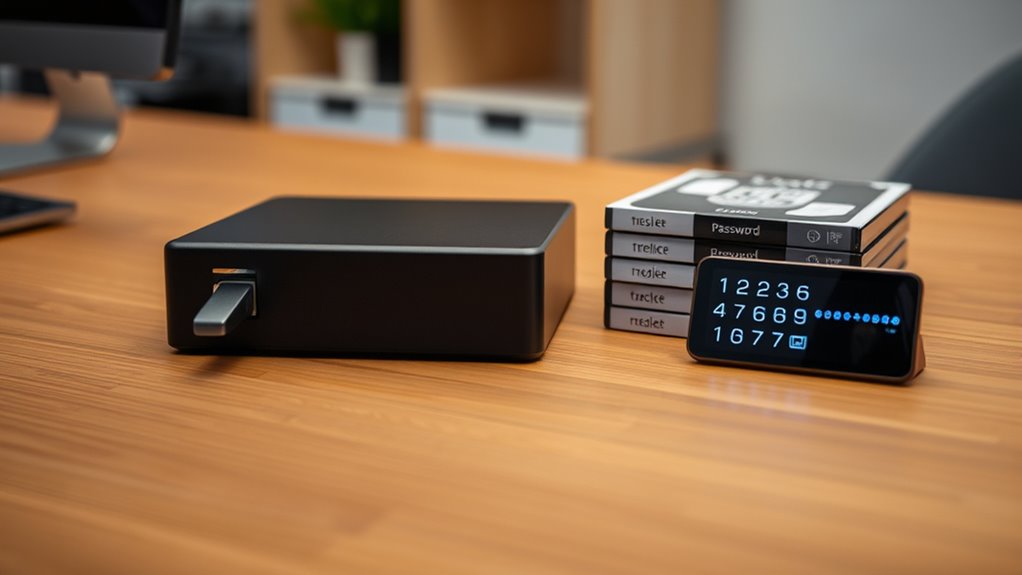
After selecting secure backup devices, protecting your data with strong passwords is the next vital step. You should prioritize password complexity by creating unique combinations of uppercase and lowercase letters, numbers, and symbols. Avoid common or easily guessable passwords to reduce the risk of unauthorized access. Implement two-factor authentication whenever possible; it adds an extra layer of security by requiring a second verification step, such as a code sent to your phone. Regularly update your passwords and refrain from reusing them across different accounts. Keep your passwords stored securely, using a password manager if needed, and never share them with others. Strong, multifaceted password protections help guarantee your personal data backups remain safe from breaches and unauthorized access. Incorporating password strength guidelines can further enhance your security approach.
Encrypting Your Backup Files
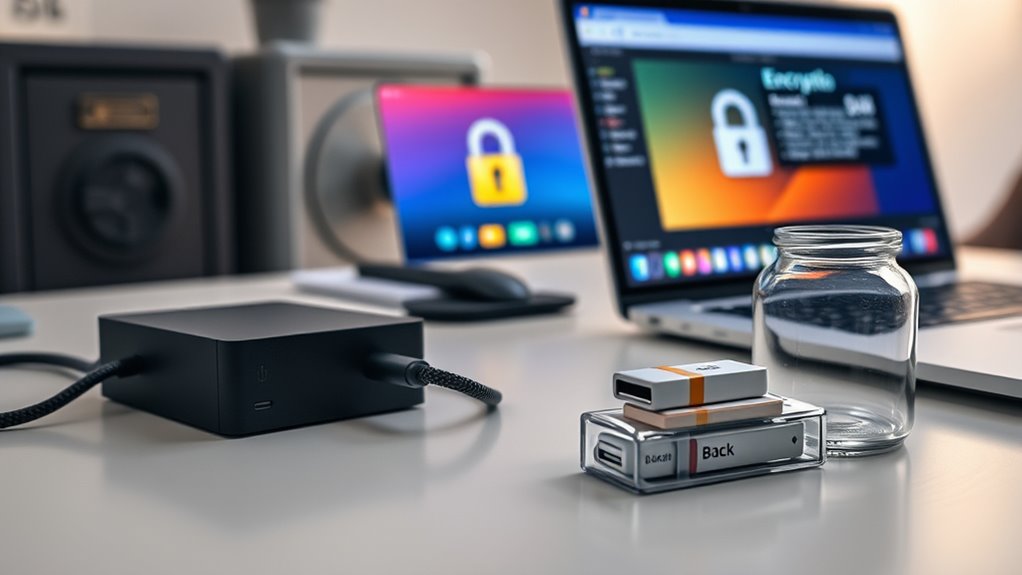
Encrypting your backup files is a vital step in safeguarding your personal data from unauthorized access. Data encryption converts your files into a protected format that only you can access with a secure password. Effective password management is essential here; choose strong, unique passwords and store them safely. Use reliable encryption tools or software that provide robust security features. When encrypting, guarantee your passwords follow best practices, avoiding common words or patterns. Encrypting your backups adds an extra layer of protection, especially if your storage device is lost or stolen. Remember, without proper data encryption, even encrypted files can be vulnerable. Additionally, selecting the best earplugs for concerts can protect your hearing during noisy storage environments. Taking these precautions helps you maintain control over your personal information and prevents unauthorized access or data breaches.
Regularly Updating Backup Copies
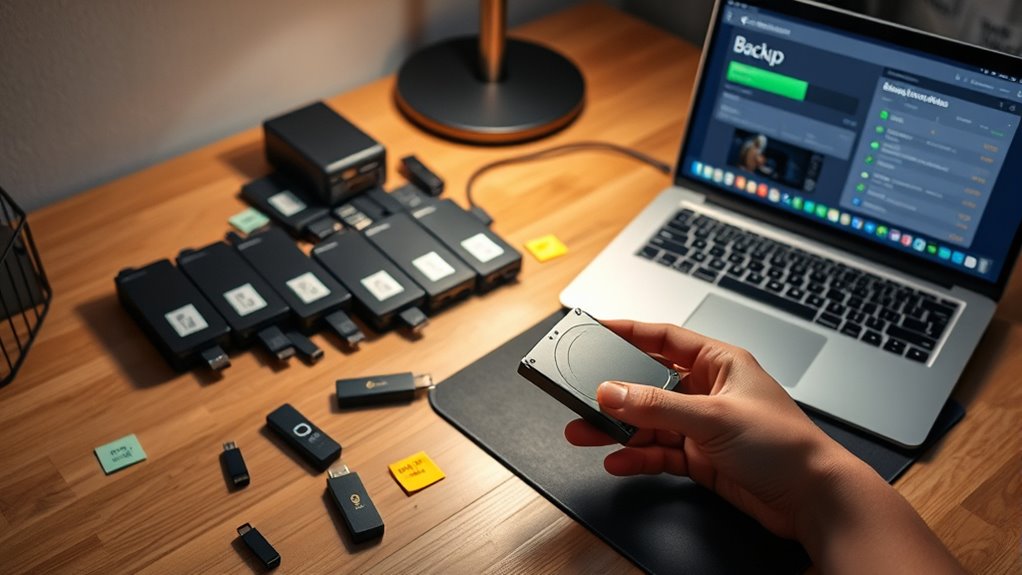
Keeping your backup copies current is vital to guarantee your data remains protected and up-to-date. Regularly updating your backups ensures that recent files and changes are saved, minimizing data loss risks. Using cloud storage makes it easier to keep backups current since many services offer backup automation, which schedules automatic updates without your intervention. This way, your data stays synchronized with minimal effort, reducing the chance of overlooking important updates. Make it a habit to review your backup schedule regularly to confirm automation is functioning correctly. Additionally, understanding quality assessment techniques can help ensure your backup media and methods are reliable and effective. By keeping your backup copies fresh and consistent, you’re better prepared for unexpected data loss or hardware failure. Automation and cloud storage streamline this process, giving you peace of mind that your personal data stays secure and current.
Storing Backups in Multiple Locations

Storing backups in multiple locations is a crucial step to protect your data from physical damage, theft, or other disasters. By doing so, you guarantee data redundancy, so losing one copy won’t mean losing everything. For example, keeping one backup locally and another in the cloud provides safety against fire or hardware failure. Cloud synchronization makes it easy to keep backups updated across devices. Consider a table like this:
| Location | Advantages |
|---|---|
| External Drive | Fast access, offline backup |
| Cloud Storage | Offsite safety, remote access |
| NAS Device | Centralized home backup |
| USB Drive | Portable, quick to deploy |
| Network Storage | Continuous data redundancy |
Using multiple locations strengthens your backup strategy and minimizes risks. Additionally, implementing necessary cookies can help monitor the effectiveness of your backup system to ensure optimal data protection.
Using Physical Security Measures

To safeguard your backups effectively, you need secure storage locations that are difficult for others to access. Implement physical access controls like locks or security cabinets to restrict entry. These measures help ensure your data stays safe from theft or accidental damage. Incorporating vocal health practices such as maintaining a controlled environment can also help preserve the integrity of your backup devices.
Secure Storage Locations
When choosing a secure storage location for your personal data backups, physical security measures are essential to prevent unauthorized access or theft. Consider storing copies in a safe, locked cabinet or a secure drawer in your home. For added protection, use offsite backups like cloud storage, which keeps your data separate from physical risks. Cloud services often have built-in security features, making them a reliable option for safeguarding backups. If you prefer physical copies, keep them in a locked safe or a concealed area, away from prying eyes. Avoid storing backups in easily accessible or vulnerable locations, such as unlocked desks or open shelves. Combining physical security with offsite backups guarantees your data remains protected against theft, damage, or loss. Additionally, understanding data protection strategies can help you implement comprehensive security measures for your backups.
Physical Access Controls
Implementing physical access controls is vital for protecting your personal data backups from unauthorized individuals. You need to establish strong physical security measures that restrict access to your backup storage. This can include locked cabinets, safes, or secure rooms. Consider who has access and ensure only trusted people can enter. Using access control methods like keys, locks, or biometric systems enhances security. Additionally, selecting energy-efficient security devices can help reduce ongoing operational costs and optimize your overall security setup.
Managing Access and Permissions

Managing access and permissions effectively is essential to protect your personal data backups from unauthorized use or accidental deletion. You should implement access control by assigning specific permissions to trusted users, ensuring only authorized individuals can view or modify your backups. Permission management involves regularly reviewing who has access and adjusting permissions as needed, especially if your circumstances change. Use strong, unique passwords for any accounts or devices involved in backup storage, and consider enabling two-factor authentication for added security. Avoid sharing access details unnecessarily, and keep a record of who has permissions. Additionally, understanding the different types of paint sprayers can help you choose the right equipment for your projects, reducing risks associated with improper handling. By controlling access and managing permissions carefully, you reduce the risk of data breaches or accidental loss, keeping your personal backups safe and secure at home.
Avoiding Common Backup Pitfalls

To guarantee your backups are reliable, you need to be aware of and avoid common mistakes that can compromise data safety. One major pitfall is neglecting proper backup scheduling, which can lead to outdated or incomplete backups. Set regular intervals to ensure your data stays current. Relying solely on cloud storage without verifying its security can be risky; choose reputable providers with strong encryption. Another mistake is storing backups in the same physical location as your devices, increasing the risk of loss from theft or disaster. Avoid inconsistent backup routines or skipping backups altogether. By establishing a consistent schedule and choosing secure cloud storage options, you minimize these mistakes and improve the integrity and safety of your personal data backups. Incorporating professional voiceover techniques into your backup process can also help reinforce the importance of data security practices.
Testing Backup Integrity Periodically
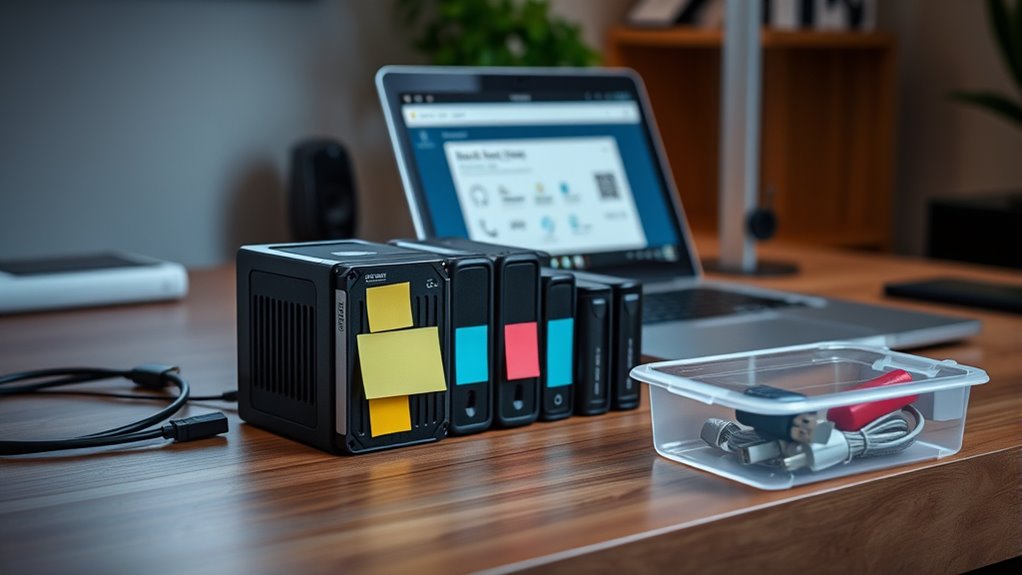
Even the most carefully planned backups can become unreliable if they aren’t tested regularly. To assure your data remains safe, you should perform periodic integrity checks. Automated testing tools can simplify this process by verifying that your backups, whether stored locally or through cloud synchronization, are intact and recoverable. Regular testing helps catch issues like corrupted files or incomplete backups before a disaster strikes. By integrating automated testing into your routine, you reduce the risk of discovering problems too late. It’s also wise to restore some backups to a separate location periodically, confirming that your backup files are functional. This proactive approach guarantees that when you need your data most, your backups will serve their purpose effectively.
Maintaining a Backup Organization System
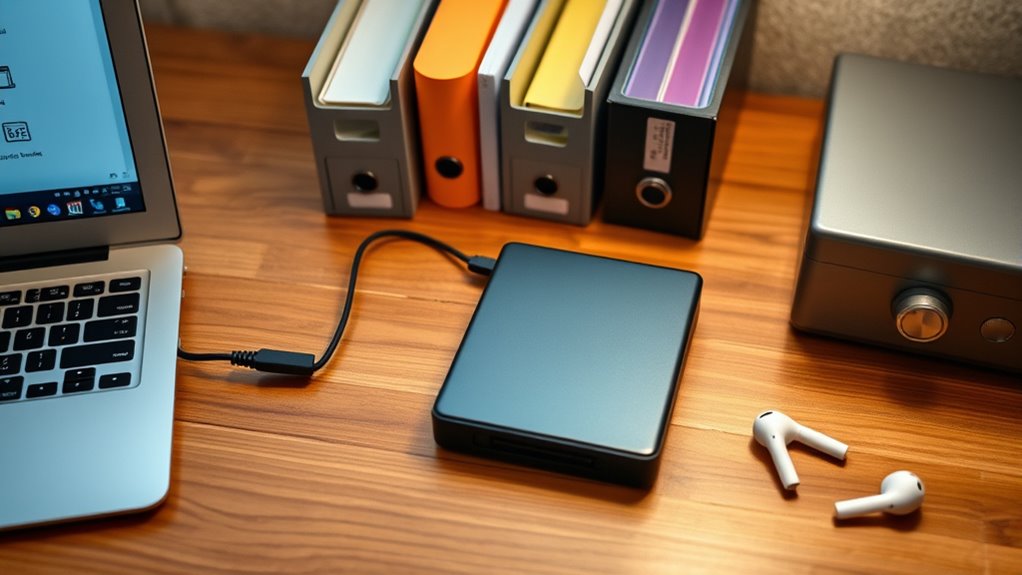
To keep your backups reliable, you need a clear organization system. Use consistent labeling and structured folders so you can find files easily. Regularly check your inventory to guarantee everything is up to date and properly stored.
Consistent Labeling Practices
Maintaining a consistent labeling system is essential for keeping your backup organization effective and easy to navigate. When you follow clear backup labeling standards, you ensure each backup is easy to identify and locate. Use a uniform format that includes key details like date, device, and data type, which promotes labeling consistency across all backups. Avoid vague labels such as “miscellaneous” or “backup,” as they make retrieval harder later. Stick to a standard naming convention so you can quickly recognize what each backup contains without opening files. Consistent labels reduce confusion and help you maintain an organized backup system, saving you time and effort when restoring data or verifying backups. Regularly review and update your labels to keep your system reliable and easy to use.
Organized Folder Structures
Creating an organized folder structure is essential for keeping your backup system efficient and easy to navigate. Start with a clear digital folder hierarchy, dividing backups into main categories like Photos, Documents, and Work Files. Within each, create subfolders for specific projects or time periods to enhance accessibility. Use consistent naming conventions for folders and files, including dates and descriptive labels, so you can quickly identify content. Avoid clutter by regularly reviewing and consolidating folders, ensuring your structure remains logical and manageable. An intuitive organization system minimizes search time and reduces the risk of overlooking important backups. By maintaining a thoughtful folder hierarchy and applying consistent naming conventions, you’ll keep your backups orderly, secure, and ready whenever you need them.
Regular Inventory Checks
Regularly checking your backup inventory is essential for guaranteeing everything stays organized and up-to-date. Performing routine inventory audits helps you identify outdated or missing backups and confirms your storage locations are accurate. To keep your system efficient, consider these steps:
- Review your current inventory list to ensure all backups are accounted for.
- Verify the storage locations match your records through location reviews.
- Remove any outdated or duplicate backups to free space.
- Update your inventory list with new backups or changes in storage methods.
Frequently Asked Questions
How Often Should I Review and Update My Backup Security Protocols?
You should review your backup security protocols at least once every three to six months to guarantee they remain effective. Regularly updating your backup frequency helps protect your data against new threats and technology changes. Conduct a security review whenever you experience significant system updates or changes in your data storage habits. Staying proactive ensures your backups stay secure, reliable, and ready for restoration when needed.
What Are the Best Practices for Disposing of Old Backup Devices Securely?
When disposing of old backup devices, you should prioritize data encryption before physical destruction. First, securely encrypt all data on the device to prevent unauthorized access. Then, physically destroy the device by methods like shredding or crushing to ensure data can’t be recovered. This two-step approach guarantees your personal data stays protected, even after the device is no longer in use. Always follow local disposal regulations for added security.
How Can I Balance Convenience and Security When Accessing Backups at Home?
Balancing convenience and security is like walking a tightrope—you want ease without falling into risks. You can do this by using strong encryption methods for your backups, ensuring data stays protected even if accessed improperly. Keep physical security tight by storing backups in a safe or lockbox. Regularly update access permissions and use password managers. This way, you enjoy quick access without compromising your data’s safety.
Are There Specific Legal Considerations for Storing Sensitive Data Backups?
When storing sensitive data backups, you need to consider legal compliance, especially if the data includes personal or confidential information. Laws may require you to protect this data with strong encryption and restrict access. You should also document your backup procedures and ensure secure storage. By doing so, you meet legal obligations, minimize risks of data breaches, and maintain trust, all while safeguarding your sensitive information effectively.
What Signs Indicate My Backup System Has Been Compromised or Is Failing?
You’ll notice signs like corrupted files or unexpected changes, which indicate your backup system might be compromised or failing. Unauthorized access could cause unusual activity, slow performance, or files that disappear or get altered without your permission. If you see these signs, it’s vital to verify your backups, run security scans, and update your security measures immediately to protect your data and prevent further issues.
Conclusion
By thoughtfully managing your backups, you create a quiet sanctuary where your personal data rests securely. Regularly updating and safeguarding these copies guarantees peace of mind, even when life’s unpredictable turns occur. Remember, a well-tended backup system acts as a gentle guardian, quietly protecting your digital memories. Embrace these habits, and you’ll find that your data’s safety is less about luck and more about mindful care—letting your peace of mind flourish quietly in the background.
